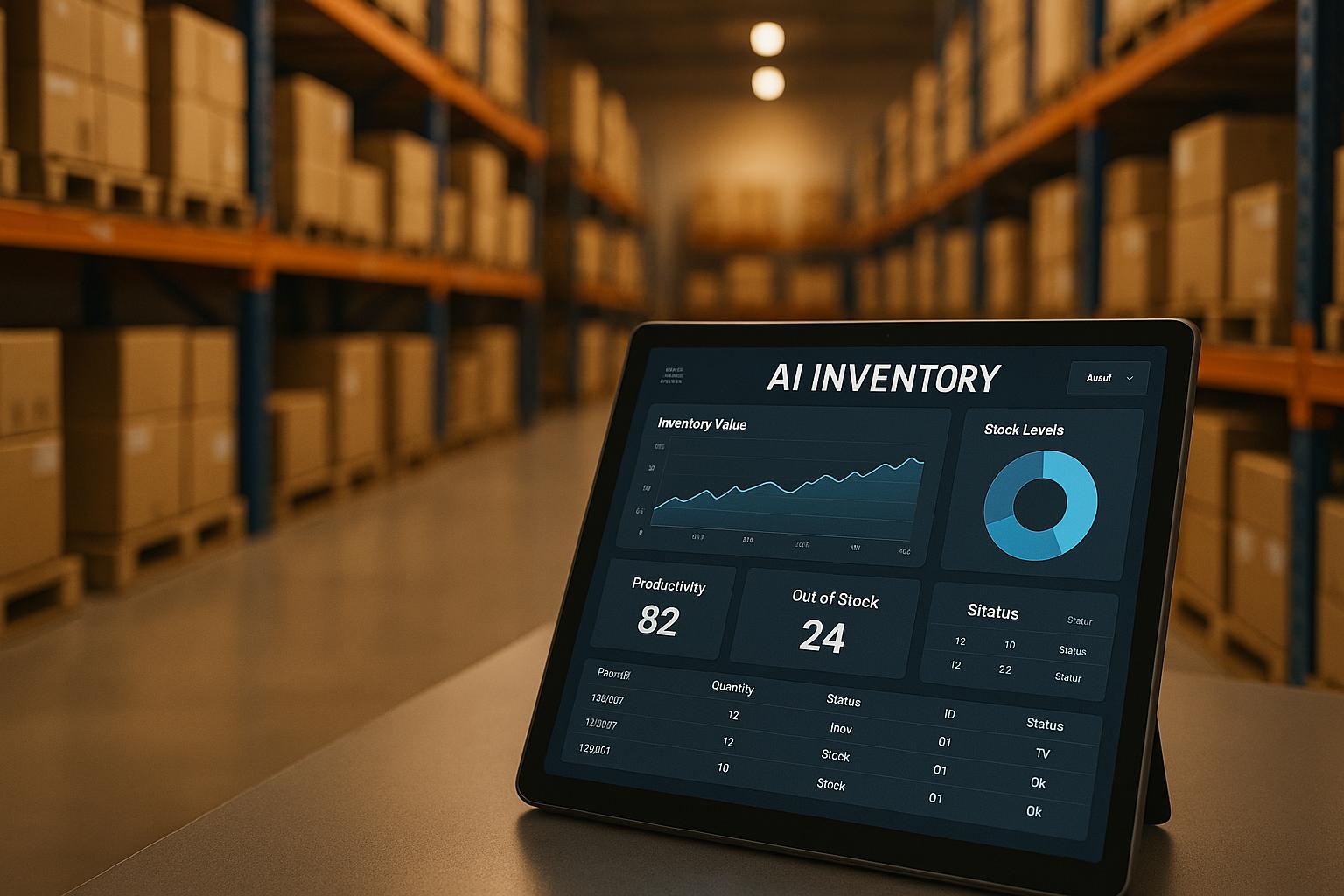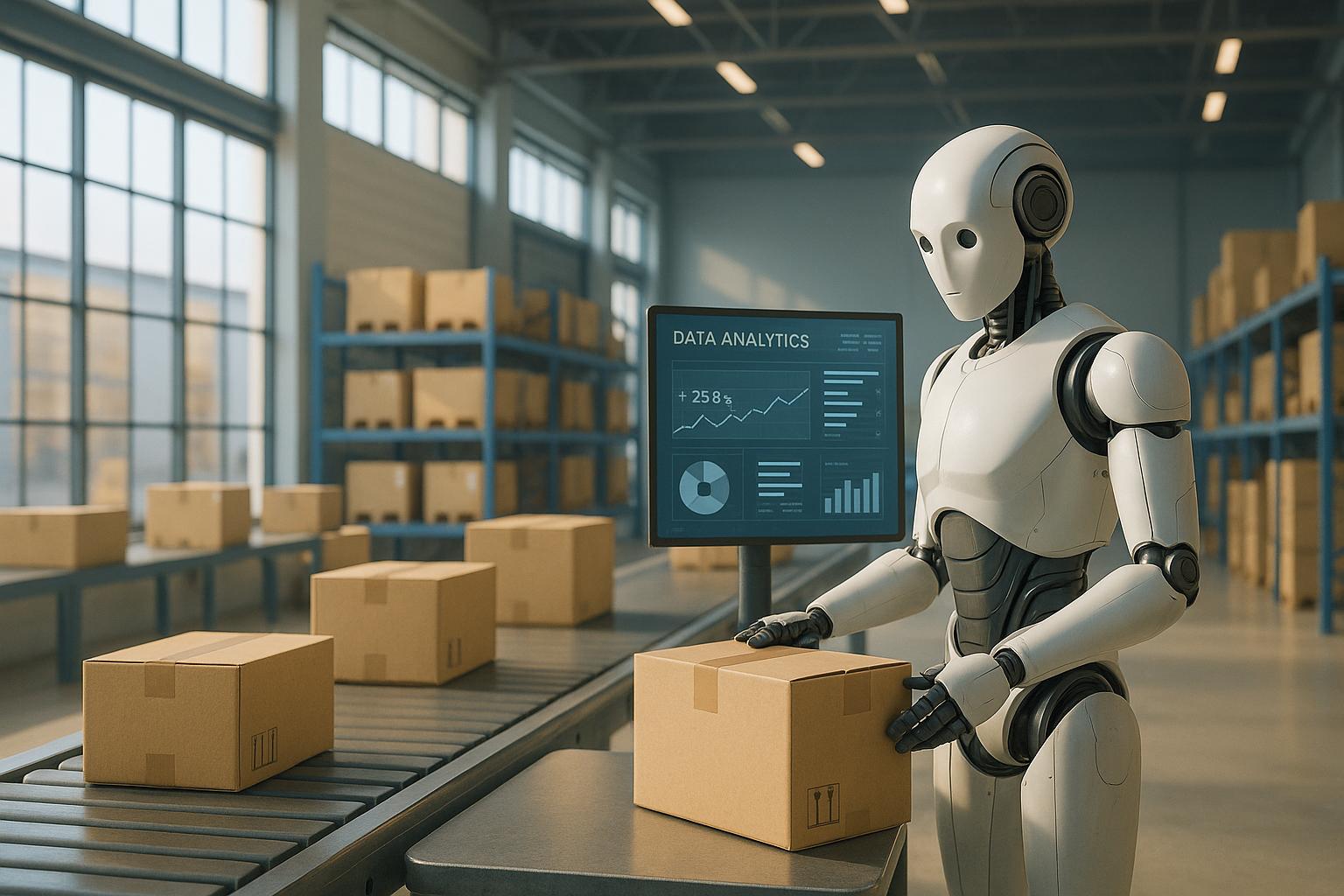
How AI Improves Custom Inventory Systems
AI is transforming inventory management for Canadian businesses by offering smarter, data-driven tools that improve efficiency, reduce costs, and enhance customer satisfaction. Here’s how:
- Demand Forecasting: AI uses predictive analytics to anticipate seasonal trends, market shifts, and even weather impacts, helping businesses prepare better.
- Real-Time Tracking: IoT devices like RFID tags and sensors provide live updates on inventory levels and conditions, ensuring accurate stock management.
- Cost Savings: Machine learning optimizes stock levels, reducing overstock, minimizing waste, and avoiding stockouts.
- Automation: Tasks like reordering and supplier monitoring are automated, cutting down on manual work and improving accuracy.
- Industry-Specific Solutions: From managing medical supplies in healthcare to tracking equipment in remote energy sites, AI addresses unique challenges across sectors.
For Canadian companies, these systems also tackle local challenges like vast geography, currency fluctuations, and regional demand variations. Businesses adopting AI see fewer stockouts, faster order processing, and lower carrying costs, making it a practical solution for staying competitive.
The Role of Artificial Intelligence in Inventory Management
Key Benefits of AI-Driven Inventory Systems
Switching to AI-powered inventory management offers a range of advantages that directly influence a business’s financial performance. These systems go beyond simple automation, actively enhancing operations, cutting costs, and improving customer experiences – all within a framework that suits Canadian businesses.
Cost Efficiency and Savings
AI-driven inventory systems are excellent at balancing stock levels and minimizing waste. Holding costs – like warehousing, insurance, and depreciation – can eat into profits, but optimizing inventory frees up valuable capital for other priorities.
Using machine learning, these systems analyse sales data and trends to calculate precise reorder quantities, reducing overstock and freeing up working capital. At the same time, they help avoid understock situations by predicting demand spikes, which reduces the risk of missed sales and unhappy customers. Automation also trims labour costs by streamlining repetitive tasks.
For Canadian businesses, AI systems bring added value by tracking currency fluctuations. By identifying the best times to make purchases, they help importers save money on exchange rates.
But the benefits don’t stop at cost savings – AI also strengthens decision-making at a strategic level.
Better Decision-Making with Predictive Analytics
Predictive analytics transforms inventory management from a reactive process into a proactive one. By analysing a wide range of data – like sales history, weather patterns, economic signals, and market trends – AI delivers more accurate demand forecasts.
Seasonal planning, for example, becomes far more reliable. AI systems can detect complex patterns, such as how specific weather conditions might influence demand for seasonal products, rather than relying on simple year-over-year comparisons.
These systems also help businesses prepare for potential supply chain issues. By monitoring supplier performance and transportation conditions, they can flag potential delays – whether it’s port congestion in Vancouver or weather-related disruptions. This allows businesses to adjust reorder schedules in advance.
On top of that, AI’s ability to spot emerging market trends ensures that inventory aligns with current consumer preferences. Since these systems continuously learn from new data, their predictions become even sharper over time, making long-term planning more reliable. This kind of accuracy helps businesses maintain steady product availability, which is key to keeping customers happy.
Fewer Stockouts and Better Customer Satisfaction
Keeping products available when customers need them is critical for maintaining satisfaction, and AI-driven systems excel at managing this balance. With real-time inventory tracking, businesses gain a clear view of stock across all sales channels – whether it’s online, in-store, or through mobile apps – avoiding the frustration of selling items that aren’t actually in stock.
Automated reordering ensures that inventory is replenished before it hits dangerously low levels. Dynamic safety stock calculations further enhance this by adjusting buffer levels based on fluctuating demand and supplier reliability, reducing the risk of disruptions.
AI tools also analyse customer behaviour to predict which products will be in high demand. This insight allows businesses to position inventory more strategically, keeping popular items readily available while avoiding overinvestment in slower-moving goods.
Additionally, optimized inventory placement across multiple locations speeds up order fulfillment, cutting down on shipping times and improving the overall shopping experience. Consistency across channels not only enhances the customer journey but also builds loyalty, turning satisfied shoppers into repeat customers.
Core AI Technologies and Methods in Inventory Management
To make smart choices about implementing AI in inventory management, Canadian businesses need to understand the core technologies driving these systems. These tools work together to create systems capable of learning, adapting, and streamlining inventory operations in real time.
Predictive Analytics for Demand Forecasting
Predictive analytics forms the backbone of demand forecasting by processing large volumes of historical and real-time data. It examines factors like sales patterns, seasonal trends, economic data, and even weather conditions to deliver accurate predictions.
Techniques such as time series analysis and the inclusion of external data sources – like economic indicators from Statistics Canada, weather reports, social media trends, and industry insights – help create more detailed forecasting models. This approach gives businesses the ability to anticipate changes in demand instead of simply reacting to them.
Modern systems use ensemble methods, which combine multiple forecasting techniques, to improve accuracy. These tools are particularly effective for established products, often outperforming traditional manual methods by a wide margin. Machine learning further enhances these strategies, refining predictions and inventory management over time.
Machine Learning for Stock Optimization
Machine learning algorithms are essential for uncovering complex patterns in inventory data, enabling businesses to optimize stock levels effectively.
- Classification algorithms categorize inventory items based on factors like demand volatility, profit margins, and supplier reliability. This allows businesses to customize management strategies – for instance, using aggressive restocking for fast-moving items and more cautious methods for seasonal goods.
- Clustering techniques group similar products, streamlining inventory management by applying shared strategies to items with similar demand trends or storage needs.
- Anomaly detection identifies unusual inventory patterns, such as sudden demand spikes or supplier delays. When anomalies occur, systems can adjust reorder points, notify managers, or suggest alternative sourcing options.
- Reinforcement learning takes optimization a step further. By learning through trial and error, these systems continuously improve inventory policies, balancing goals like cost reduction, service level improvement, and waste minimization. As new data is added, machine learning models retrain themselves, ensuring they stay accurate and effective.
IoT Integration for Real-Time Tracking
While analytics and machine learning focus on decision-making, IoT (Internet of Things) integration provides the real-time data needed to ground those decisions in reality. IoT devices like sensors, tags, and trackers offer a detailed, up-to-the-minute view of inventory across the supply chain.
- RFID tags and smart sensors automate tracking and monitor conditions, delivering constant updates on inventory status without requiring manual labour. This is especially valuable for Canadian businesses handling temperature-sensitive items during harsh winters.
- Weight sensors on storage shelves track inventory levels as items are added or removed, eliminating the need for manual counts and ensuring accurate data for AI systems.
- GPS tracking provides real-time visibility for shipments. In a country as large as Canada, where weather can delay transportation, knowing the exact location of goods helps adjust delivery expectations and reorder timing.
The combination of IoT and AI creates a self-sustaining feedback loop. IoT devices supply real-time data, enabling AI algorithms to make smarter decisions, while AI optimizes how IoT devices operate, such as by adjusting monitoring schedules or alert thresholds.
This integration also supports automated replenishment. IoT sensors can detect when stock is running low and trigger reorders through AI-driven purchasing systems – no human intervention required. This ensures inventory levels stay optimal while reducing administrative work, creating a seamless and efficient system for managing stock.
sbb-itb-fd1fcab
Implementation Strategies for Canadian Businesses
Integrating AI into custom inventory systems can be a game-changer for Canadian businesses. But doing it right means considering Canada’s unique business landscape, regulatory requirements, and operational hurdles. Transitioning from traditional inventory management to AI-powered systems takes careful planning, but the payoff – greater efficiency and cost savings – is worth the effort.
Steps to Integrate AI into Existing Systems
Start by conducting a thorough audit of your current inventory processes, data quality, and system capabilities. Often, inventory data is scattered across multiple platforms, making it vital to assess its accuracy, consistency, and completeness. This step ensures you’re working with reliable information.
Next, consolidate and clean your data. Many Canadian businesses struggle with issues like inconsistent product codes, duplicate entries, or incomplete historical records. Standardizing product classifications, naming conventions, and sales data creates a solid foundation for AI integration. Think of it as creating a "single source of truth" for your inventory.
Once your data is in order, choose the right AI technologies for your needs. For example:
- Predictive analytics can help forecast seasonal demand.
- Machine learning is ideal for managing complex supply chains.
- IoT solutions provide real-time updates on perishable goods.
Before rolling out AI across your entire operation, pilot test it on a smaller scale – perhaps with one product line or a single warehouse. This allows you to measure key performance indicators like forecast accuracy, inventory turnover, and stockout reductions. It’s a low-risk way to validate the system’s effectiveness.
Finally, ensure seamless integration with your existing systems. AI tools should work smoothly with established ERP platforms through APIs and data connectors, allowing for real-time data flow without disrupting daily operations.
The Role of Data Quality and Customization
Data quality is the backbone of successful AI implementation. For Canadian businesses, this means ensuring inventory data is complete and accurate, covering everything from product descriptions to supplier details and regional demand patterns. Without reliable data, even the most advanced AI can’t deliver meaningful insights.
Customization is equally important. AI systems should be tailored to Canada’s specific needs, such as:
- Addressing regional demand variations (e.g., different product preferences in Vancouver versus Halifax).
- Accommodating bilingual requirements.
- Factoring in provincial tax structures, shipping distances, and local supplier networks.
Real-time data processing is crucial for businesses operating across multiple time zones. Whether you’re in Newfoundland or British Columbia, having AI systems that continuously update inventory data keeps operations running smoothly.
Don’t overlook compliance with Canadian privacy laws like PIPEDA. Proper data governance is essential to protect customer information while ensuring your AI systems function effectively.
Partnering with Digital Fractal Technologies Inc

Having a strong implementation strategy is key, but expert guidance can make the process smoother. Digital Fractal Technologies Inc specializes in creating custom AI-driven inventory solutions tailored to Canadian businesses. Their expertise spans industries like public sector operations, energy, and construction, where efficient inventory management is critical.
The company’s custom software development capabilities ensure seamless integration with existing systems. Their solutions are built to address specific industry challenges, regulatory requirements, and operational workflows.
Digital Fractal also offers AI consulting services, helping businesses navigate complex technologies like machine learning and predictive analytics. Whether you need demand forecasting algorithms or IoT strategies, their team ensures you choose solutions that align with your goals.
Their industry-specific approach reflects a deep understanding of the Canadian market. For example:
- Public sector clients benefit from systems designed for government procurement transparency.
- Energy and construction industries get tools for managing critical equipment, project-based inventory, and supplier relationships.
A scalable implementation strategy allows businesses to start small – focusing on specific AI deployments – and expand over time. This minimizes risks while offering a clear path for growth. Plus, ongoing support ensures your AI systems keep up with changing market conditions, so you’re always ahead of the curve.
Real-World Applications and Outcomes
AI-driven inventory systems are no longer just theoretical concepts – they’re delivering real results for Canadian businesses. By reshaping inventory management, these systems are helping companies turn potential benefits into measurable outcomes. From cutting costs to improving efficiency, the impact is being felt across a wide range of industries.
Measurable Benefits in Inventory Management
AI-powered inventory solutions are making a noticeable difference. Businesses across Canada report fewer stockouts, which not only reduces lost sales but also boosts customer satisfaction. This is especially crucial in competitive markets where every sale counts.
Order fulfilment processes have also seen major upgrades. AI helps optimize where inventory is stored and forecasts demand more accurately, speeding up processing times. This is particularly valuable in a country as large as Canada, where shipping distances can be significant.
By predicting demand and optimizing stock levels, companies are cutting down on storage and carrying costs. Machine learning algorithms enhance forecast accuracy, leading to smarter purchasing decisions and stronger supplier relationships.
Automation is another key advantage. Routine tasks that once consumed hours of staff time are now handled by AI, freeing employees to focus on more strategic work. These improvements are being realized across various sectors in Canada, showing just how versatile these systems can be.
Examples from Canadian Industries
The results speak for themselves when you look at how different industries are using AI inventory systems. For instance, in construction, these systems are helping manage the complex needs of multiple job sites. By coordinating inventory and reducing waste, they ensure that essential materials are available when and where they’re needed.
Public sector organizations are also seeing the benefits. Government agencies across Canada are using AI to streamline procurement processes, improve transparency, and manage resources more efficiently – all of which ultimately serve taxpayers better.
In the energy sector, particularly in oil and gas, AI is helping companies manage critical equipment and spare parts in remote locations. By predicting maintenance needs and ensuring timely availability of parts, these systems minimize costly downtime.
Manufacturers in provinces like Ontario and Quebec are leveraging AI to balance raw material inventory and the distribution of finished goods. This helps them handle seasonal demand shifts and navigate supply chain disruptions more effectively.
Retailers, on the other hand, are using AI to adapt to regional preferences, seasonal trends, and local market conditions. This ensures that inventory is distributed optimally across multiple locations, meeting customer needs more efficiently.
A great example of this in action is Digital Fractal Technologies Inc, which has partnered with organizations in these sectors to deliver custom AI solutions tailored specifically for the Canadian market. Their approach takes into account regulatory requirements, regional challenges, and operational nuances, ensuring these systems are not just effective but also practical for local businesses.
The results from these implementations are clear: AI is revolutionizing inventory management for Canadian businesses. By improving cost-efficiency, streamlining operations, and enhancing customer satisfaction, these systems are proving to be a game-changer across industries.
Conclusion
AI-driven inventory systems are offering Canadian businesses a chance to modernize and maintain their competitive edge in an ever-evolving market. Companies adopting this technology are seeing real improvements in their operational efficiency and financial performance.
Key Takeaways for Canadian Businesses
AI adoption is helping businesses save money by cutting down on carrying costs, optimizing storage, and reducing waste. For Canadian companies, this also means better demand forecasting – an essential tool for tackling the unique challenges of serving diverse markets across the country’s expansive geography.
Predictive analytics is transforming decision-making. Businesses can now anticipate market trends, seasonal changes, and supply chain issues before they create problems. This is particularly important in Canada’s resource-driven economy, where fluctuations in commodity prices and weather-related disruptions can heavily influence inventory needs.
Automation, such as real-time tracking and automatic reordering, is freeing up staff to focus on more strategic priorities. Many Canadian companies report faster order fulfilment, fewer stockouts, and happier customers – key elements for staying ahead in today’s competitive landscape.
These systems are proving effective across a wide range of industries. Whether it’s a construction company managing materials across multiple job sites or an energy firm maintaining vital equipment in remote areas, AI is meeting specific sector needs while delivering consistent results.
Next Steps for AI Integration
Start by conducting an inventory audit to pinpoint issues like stockouts, high costs, or inefficiencies in manual processes.
The success of any AI system depends on the quality of your data. Ensure your inventory data is accurate, complete, and well-organized – this step is crucial for getting the most out of machine learning and predictive tools.
Collaborating with experts who understand the Canadian business environment can make a big difference. For example, Digital Fractal Technologies Inc specializes in custom software and AI solutions tailored to Canadian organizations. With experience in industries like public services, energy, and construction, they’re well-versed in the regulatory and operational challenges unique to Canada.
FAQs
How can AI-powered inventory systems help Canadian businesses adapt to regional demand and currency changes?
AI-powered inventory systems are helping Canadian businesses manage regional demand more effectively through demand forecasting and regional analytics. By using these tools, companies can fine-tune stock levels to match the specific needs of different provinces and cities. This not only minimizes waste but also ensures that products are readily available where they’re most in demand.
When it comes to currency fluctuations, AI models analyse real-time market trends to refine pricing and procurement strategies. By predicting shifts in exchange rates, businesses can reduce financial risks and protect their bottom line. This ability to adapt keeps Canadian companies efficient and resilient, even in a constantly changing market landscape.
How can Canadian businesses seamlessly integrate AI into their inventory systems?
To make AI work effectively in their inventory systems, Canadian businesses should start by pinpointing specific issues they want to solve. For instance, they might struggle with inaccurate demand forecasting or inefficient stock management. Setting clear objectives, such as improving real-time tracking or cutting down on overstock, can provide a clear direction.
Businesses also need to ensure that AI tools fit seamlessly with their current systems, like ERP platforms. Features such as customizable dashboards and API integration can make this process smoother. Training employees to feel confident using AI-based tools is another key step in ensuring successful adoption. Additionally, implementing a system for regular monitoring will help maintain performance and adjust to evolving business needs. With these steps, businesses can use AI to improve inventory management while meeting local operational demands effectively.
How do IoT devices enhance AI-powered inventory systems for real-time tracking and smarter decision-making?
The combination of IoT devices and AI-driven inventory systems is transforming how businesses manage their stock. By using sensors attached to inventory items, companies can achieve real-time tracking, capturing critical details like location, condition, and environmental factors with impressive precision.
AI takes this constant stream of data and turns it into actionable insights. It can anticipate when stock needs replenishing, suggest the best storage arrangements, and pinpoint areas where processes could be improved. This approach not only boosts efficiency and cuts down on manual mistakes but also allows businesses to adapt swiftly to shifting demands, giving them tighter control over their inventory management.

